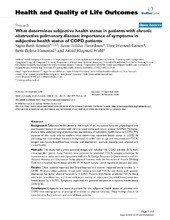What determines subjective health status in patients with chronic obstructive pulmonary disease: importance of symptoms in subjective health status of COPD patients
Bentsen, Signe Berit; Henriksen, Anne Hildur; Wentzel-Larsen, Tore; Hanestad, Berit Rokne; Wahl, Astrid Klopstad
Peer reviewed, Journal article
Published version

Date
2008-12-18Metadata
Show full item recordCollections
Original version
https://doi.org/10.1186/1477-7525-6-115Abstract
Background: Subjective health status is the result of an interaction between physiological and psychosocial factors in patients with chronic obstructive pulmonary disease (COPD). However, there is little understanding of multivariate explanations of subjective health status in COPD. The purpose of this study was to explore what determines subjective health status in COPD by evaluating the relationships between background variables such as age and sex, predicted FEV1%, oxygen saturation, breathlessness, anxiety and depression, exercise capacity, and physical and mental health. Methods: This study had a cross-sectional design, and included 100 COPD patients (51% men, mean age 66.1 years). Lung function was assessed by predicted FEV1%, oxygen saturation by transcutaneous pulse oximeter, symptoms with the St George Respiratory Questionnaire and the Hospital Anxiety and Depression Scale, physical function with the Incremental Shuttle Walking Test, and subjective health status with the SF-36 health survey. Linear regression analysis was used. Results: Older patients reported less breathlessness and women reported more anxiety (p < 0.050). Women, older patients, those with lower predicted FEV1%, and those with greater depression had lower physical function (p < 0.050). Patients with higher predicted FEV1%, those with more breathlessness, and those with more anxiety or depression reported lower subjective health status (p < 0.050). Symptoms explained the greatest variance in subjective health status (35%–51%). Conclusion: Symptoms are more important for the subjective health status of patients with COPD than demographics, physiological variables, or physical function. These findings should be considered in the treatment and care of these patients.
Publisher
BioMed CentralJournal
Health and Quality of Life OutcomesCopyright
Copyright 2008 Bentsen et al; licensee BioMed Central LtdSigne Bentsen et al.; licensee BioMed Central Ltd.
